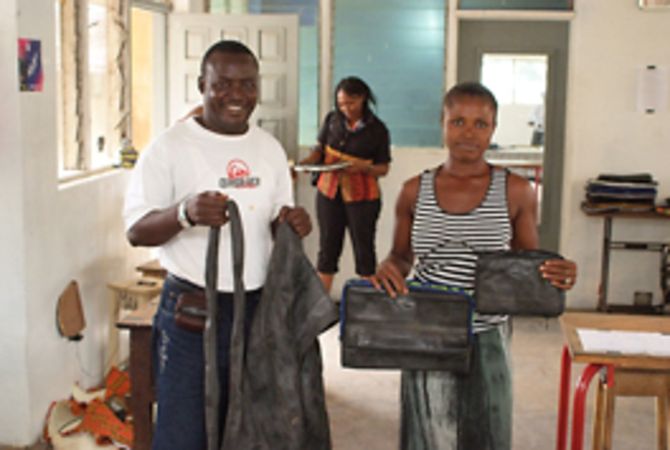Starting point
Sierra Leone is one of the poorest countries in the world, even 10 years after the long civil war (1991-2002). The country is still suffering from the consequences today: Before the war started, leprosy was already almost under control: of formerly 12,000 patients (1975, all people suffering from leprosy) the number had decreased to approximately 1,200 by 1990, with only 300 new cases.
Despite the turmoil of the war, the former representative of DAHW, Antoinette Fergusson, stayed in the country and continued her work together with her entire team, which was a very dangerous undertaking. This was, however, not possible everywhere in the country, as some regions were cut off from the outside world completely.
Supplying medicine, orthopaedic shoes or bandaging material was impossible in these regions. Due to a lack of care, leprosy reactions in patients increased which often made amputations necessary. When it was possible for DAHW to continue their work all over the country for the first time after the war, the number of new cases rose to more than 700; in 2009 there were still 462 new patients.
Furthermore, there is a large number of war disabled veterans - mine victims or survivors of massacres of marauding soldiers. This led those responsible at DAHW to understand that CBR ("community-based rehabilitation") was the right approach for sustainable support: Projects for all people with disabilities, no matter if they have a leprosy background or not.
Aims of the project
Masanga is within sight of the "Diamond Road“ – the road between Bo and Makeni where during the civil war blood diamonds were taken to the nearby airport to be able to continue fighting the war. The rice fields dried out because nobody dared to go outside to do the necessary work on the fields. Soldiers completely destroyed the hospital which was about one kilometre away.
Of the originally 500 inhabitants, only about 150 still live in Masanga today, 12 of them are or were suffering from leprosy – almost all of them show clearly visible traces of the disease. Ten other people who are disabled veterans are also not able to cultivate their fields without help.
DAHW wants to make a normal life possible for people with disabilities in Masanga and wants them to fully be able to participate in society. At the same time, the village is to act as a community in order to be able to support themselves also in the long run.
Activities
A Danish organisation is currently rebuilding the nearby hospital. DAHW provided its support for some of the buildings, one of them is now the regional office for the national leprosy control programme. DAHW supports local initiatives in other buildings which enable vocational training for young people from the region.
One of DAHW's social workers founded a self-help group in the village, which all inhabitants take part in - also the old, poor and weak inhabitants as well as people with disabilities. The aim of this group is to go back to cultivating the fields that have been left barren and untended and to not only feed the village with the harvest but to be able to assure the entire village’s livelihood from it in the long term. Hitherto the people in Masanga had only used a small part of the fields to supply themselves.
According to the principle of a co-operative society, every member of the village will from now on contribute by carrying out a task which is suitable for him or her: In this way, people with disabilities can also contribute their share of the work and thus have the right to an equal share of the yield.
What was achieved in 2010?
CBR is a continuous process to strengthen civil society and in Masanga some success is already visible: The first students have completed their vocational training in the sewing room and can now earn their own living with their craft.
The fields of the village have grown as well: rice is now cultivated on three hectares. In 2010, the inhabitants could for the first time sell rice and cassava on the surrounding markets. The harvest yielded more than the people need to feed themselves. For the first time in many years there is now an outlook for their little village.
Plans for 2011
The inhabitants of Masanga want to make their village stronger step by step - DAHW's social workers support them in this effort. Their plan for 2011 is to generate surpluses of rice and cassava again. Furthermore, they want to try and see if they can cultivate other crops on their fields as well, such as peanuts. The community wants to build up reserves from the sale of these products to be able to make bigger investments later on - to purchase modern tools for work in the fields, for instance.
In addition, DAHW's social workers want to turn the adjacent hospital into a social centre and further extend vocational training. Masanga is to serve as a role model for the approximately 30 other villages in the vicinity of the hospital.
Risks of the project
The greatest risk in Sierra Leone is the precarious political situation. The country's extreme poverty and the prospect of becoming wealthy quickly on the diamond fields started the civil war and the same reasons could lead to conflicts again at anytime.
During the civil war, DAHW's employees stayed in the country and tried to continue their work in leprosy control despite all the dangers; they managed to do so only in approximately 70% of the country.
Whether the village community in Masanga will be able to generate enough income solely by selling their harvest also depends on the economic conditions in the country and whether it will manage to sell its goods on markets in bigger cities as well.



